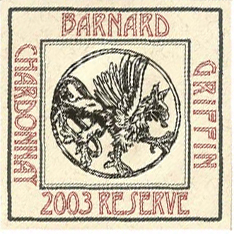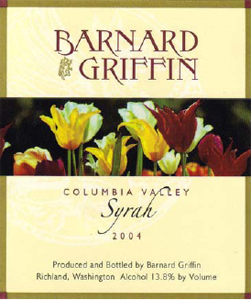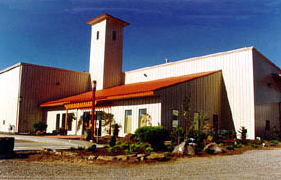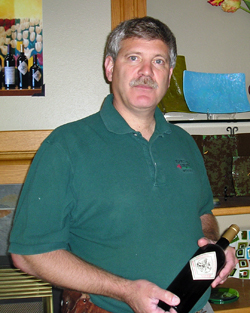

Bernard Griffin's winemaking proprietor is expanding his horizons with his new business, Vinagium.
Washington (State Appellation)
Washington State Grapes
+ Winemaker Rob Griffin
= A Brilliant, Expanding Future
With some 30 years of winemaking in Washington, Rob Griffin reflects on how the State’s wine industry has grown and prospered by respecting and nurturing its terroir.
by
Anne Sampson
October 12, 2007
Anne Sampson (AS): You’ve grown up along with the Washington wine industry. How would you characterize its development?
Rob Griffin (RG): I see it as a long uphill struggle. In the early days, making and selling wine in Washington was strange behavior; it was an anomaly. There wasn’t a market for all this Washington wine. For people who have been in the business for 10 or 15 years, it’s been a lot easier. That doesn’t mean that I had to work any harder, necessarily; it just forms your attitudes about the business.
The wine business is one of the most competitive in the world. The classic example: if you go to the store, you might find 12 brands of toothpaste you can buy, but in the state of Washington, there are maybe 4000 brands of wine you can buy, maybe 5000 or 6000, maybe 10,000. Nobody knows that number, but it’s absolutely huge. In wine, you’re competing with your neighbors, with people from the south in California, with people from Australia and South America. It’s truly global competition.
can buy, maybe 5000 or 6000, maybe 10,000. Nobody knows that number, but it’s absolutely huge. In wine, you’re competing with your neighbors, with people from the south in California, with people from Australia and South America. It’s truly global competition.
AS: Who or what is your biggest competition?
RG: You’d almost have to go market by market to explain that. In the global world, whether it’s grocery stores or wine shops, there’s always somebody anxious to take your position. So I don’t know that there’s any one area or branch you can point at and say they’re our biggest competition. If we consider Washington wine a category and people buy within that category, naturally other Washington wines would be my biggest competition, but I don’t know that that’s true at all. As there are more wines made in Washington, the category gets more recognition, and it gets larger. I think competition is just other wine. It doesn’t matter where it comes from.
AS: You said it’s been an uphill struggle. Obviously, it takes years to build ‘brand recognition’ for a product or category like Washington wines. And, of course, as a winemaker, you’ve developed your skills over the years. Has the overall quality of the fruit grown in Washington moved forward, as well?
RG: Yes. People always ask if it’s the age of the vine, and I say, only partially facetiously, “No it’s the age of the grower.” They’re actually learning to do their job better and hence the quality goes up. The whole comprehension of Washington grapes is so much better than when I got here. It was sort of a marginally exotic crop only a few people were working with, and they were either transplants from a different climate like California or, just as likely, they were farmers trying something new.
You know, if you’re growing mint and Concord grapes (crops widely planted in the Columbia Valley), fertilizer and water are your salvation, and that’s just exactly what you don’t want to overdo when you’re growing wine grapes. Getting that dialed in takes time. As a region, by no means have we answered all the questions but we’re sure getting better than we used to be. I think the wines are getting better than they used to be.
AS: How do Washington wines compare to the rest of the marketplace?
RG: I think when Washington wines are compared with other wines made in the United States, they are always in the top tier, very often the best. Now, I grew up in California, so I have all the passion of a recent convert. We make great wines here. They make great wines other places, too. You can never expect to compete with the established generations and traditions from Bordeaux or Burgundy or any of the other great regions of France. Even on some absolute scale, of which none exists in the wine business,
The Bernard Griffinn winery is in Richland, Washington.you’re still not going to be Chateau Lafitte. Can we make a marvelous product and do it at a profit? Yes. Washington is a great place to be. But it’s naïve to think we can make better wines than places like Bordeaux, and it’s even more naïve to think we’re going to get recognition for it very quickly if we do.
AS: Until recently, you’ve stayed out of the vineyards, choosing instead to source all of your grapes from vineyards across the Columbia Valley. Why have you avoided owning your own vineyards?
RG: Several reasons. One, I’m a winemaker; I’m not a grape grower. And it would have been a stretch financially in the beginning to plant a vineyard. When we started Barnard Griffin, Maury Balcom (of Balcom & Moe, one of the earliest growers in Washington to develop a crop of wine grapes) loaned me four tons of grapes. I guess I was a good investment, because he still sells grapes to me.
But truly, another very important reason is that when you have your own vineyard, you’re tied to it. There are a lot of very good grapes in a lot of very distinct places in Washington, and by blending them together I think I make a better product.
 A varied selection of Red Mountain wines are now conveniently available Directly from the Wineries
A varied selection of Red Mountain wines are now conveniently available Directly from the Wineries in APPELLATION AMERICA's
online wine store. But it’s also important to understand that better is a shifting target, very subject to fashion and style, like any other business. What was considered the paradigm of great red wine 20 years ago is different than what it is today, and it may change again.
AS: You’ve pointed out that the industry constantly grows and changes, along with tastes and styles of wines. But some of that is driven by the evolution of the fruit. New trellising methods, for example, can produce higher sugars and Brix. How much has climate change over the last few decades affected your wines?
RG: I can remember the first harvest I worked with up here in 1977; we didn’t harvest any fruit before October. Now it’s early September, and that’s a big difference. Cultural practices, individual seasons, all of that to one side, I think we’re still a couple of weeks ahead of where we used to be. If you study the heat summation index, there’s no question it’s warmer. We can’t ignore the issue of global climate change or global warming. Call it what you will, it is getting warmer out there. You have to be aware of it, and you have to keep your ideas, your data gathering and so forth, fluid. You can’t say ‘I’m going to pick in October’ and leave it at that. You have to be prepared a little earlier.
AS: Will later-ripening varieties become stronger players as a result?
RG: I think (that) later season varietals definitely have a stronger future tha
Rob Griffin (RG): I see it as a long uphill struggle. In the early days, making and selling wine in Washington was strange behavior; it was an anomaly. There wasn’t a market for all this Washington wine. For people who have been in the business for 10 or 15 years, it’s been a lot easier. That doesn’t mean that I had to work any harder, necessarily; it just forms your attitudes about the business.
The wine business is one of the most competitive in the world. The classic example: if you go to the store, you might find 12 brands of toothpaste you can buy, but in the state of Washington, there are maybe 4000 brands of wine you
 can buy, maybe 5000 or 6000, maybe 10,000. Nobody knows that number, but it’s absolutely huge. In wine, you’re competing with your neighbors, with people from the south in California, with people from Australia and South America. It’s truly global competition.
can buy, maybe 5000 or 6000, maybe 10,000. Nobody knows that number, but it’s absolutely huge. In wine, you’re competing with your neighbors, with people from the south in California, with people from Australia and South America. It’s truly global competition.
AS: Who or what is your biggest competition?
RG: You’d almost have to go market by market to explain that. In the global world, whether it’s grocery stores or wine shops, there’s always somebody anxious to take your position. So I don’t know that there’s any one area or branch you can point at and say they’re our biggest competition. If we consider Washington wine a category and people buy within that category, naturally other Washington wines would be my biggest competition, but I don’t know that that’s true at all. As there are more wines made in Washington, the category gets more recognition, and it gets larger. I think competition is just other wine. It doesn’t matter where it comes from.
AS: You said it’s been an uphill struggle. Obviously, it takes years to build ‘brand recognition’ for a product or category like Washington wines. And, of course, as a winemaker, you’ve developed your skills over the years. Has the overall quality of the fruit grown in Washington moved forward, as well?
RG: Yes. People always ask if it’s the age of the vine, and I say, only partially facetiously, “No it’s the age of the grower.” They’re actually learning to do their job better and hence the quality goes up. The whole comprehension of Washington grapes is so much better than when I got here. It was sort of a marginally exotic crop only a few people were working with, and they were either transplants from a different climate like California or, just as likely, they were farmers trying something new.
You know, if you’re growing mint and Concord grapes (crops widely planted in the Columbia Valley), fertilizer and water are your salvation, and that’s just exactly what you don’t want to overdo when you’re growing wine grapes. Getting that dialed in takes time. As a region, by no means have we answered all the questions but we’re sure getting better than we used to be. I think the wines are getting better than they used to be.
AS: How do Washington wines compare to the rest of the marketplace?
RG: I think when Washington wines are compared with other wines made in the United States, they are always in the top tier, very often the best. Now, I grew up in California, so I have all the passion of a recent convert. We make great wines here. They make great wines other places, too. You can never expect to compete with the established generations and traditions from Bordeaux or Burgundy or any of the other great regions of France. Even on some absolute scale, of which none exists in the wine business,

The Bernard Griffinn winery is in Richland, Washington.
AS: Until recently, you’ve stayed out of the vineyards, choosing instead to source all of your grapes from vineyards across the Columbia Valley. Why have you avoided owning your own vineyards?
RG: Several reasons. One, I’m a winemaker; I’m not a grape grower. And it would have been a stretch financially in the beginning to plant a vineyard. When we started Barnard Griffin, Maury Balcom (of Balcom & Moe, one of the earliest growers in Washington to develop a crop of wine grapes) loaned me four tons of grapes. I guess I was a good investment, because he still sells grapes to me.
But truly, another very important reason is that when you have your own vineyard, you’re tied to it. There are a lot of very good grapes in a lot of very distinct places in Washington, and by blending them together I think I make a better product.
 A varied selection of Red Mountain wines are now conveniently available Directly from the Wineries
A varied selection of Red Mountain wines are now conveniently available Directly from the Wineries online wine store.
AS: You’ve pointed out that the industry constantly grows and changes, along with tastes and styles of wines. But some of that is driven by the evolution of the fruit. New trellising methods, for example, can produce higher sugars and Brix. How much has climate change over the last few decades affected your wines?
RG: I can remember the first harvest I worked with up here in 1977; we didn’t harvest any fruit before October. Now it’s early September, and that’s a big difference. Cultural practices, individual seasons, all of that to one side, I think we’re still a couple of weeks ahead of where we used to be. If you study the heat summation index, there’s no question it’s warmer. We can’t ignore the issue of global climate change or global warming. Call it what you will, it is getting warmer out there. You have to be aware of it, and you have to keep your ideas, your data gathering and so forth, fluid. You can’t say ‘I’m going to pick in October’ and leave it at that. You have to be prepared a little earlier.
AS: Will later-ripening varieties become stronger players as a result?
RG: I think (that) later season varietals definitely have a stronger future tha











 READER FEEDBACK: To post your comments on this story,
READER FEEDBACK: To post your comments on this story,




